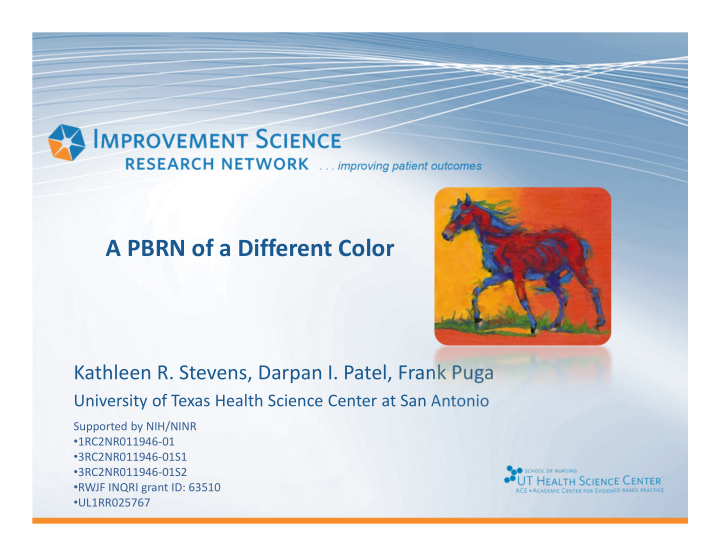



A PBRN of a Different Color Kathleen R. Stevens, Darpan I. Patel, Frank Puga University of Texas Health Science Center at San Antonio Supported by NIH/NINR • 1RC2NR011946 ‐ 01 • 3RC2NR011946 ‐ 01S1 • 3RC2NR011946 ‐ 01S2 • RWJF INQRI grant ID: 63510 • UL1RR025767
LABORATORY Catalysts • Improving our work is our work. • Future of healthcare calls for interprofessional transformation for quality, safety, and value across all settings • Lead with evidence of ‘what works’
LABORATORY The ISRN includes: – Mission – Technology infrastructure Website: www.isrn.net – Network members – Priorities – Steering Council – Coordinating Center (Base: Academic Center for Evidence- Based Practice, University of Texas Health Science Center San Antonio)
LABORATORY Definition of “Improvement Science” A field of research focused on healthcare and process improvement at individual provider, microsystem, and system levels Determines improvement strategies that work in assuring effective and safe patient care Related terms: translational science implementation science evidence-based practice knowledge translation research utilization
LABORATORY ISRN Mission: To advance the scientific foundation for quality improvement, safety and efficiency through transdisciplinary research addressing healthcare systems, patient- centeredness, and integration of evidence into practice. Unique infrastructure for conducting improvement research— a collaboratory for research NINR/NIH-supported improvement infrastructure for a research network.
LABORATORY ISRN Research Priorities Established national consensus on research priorities: A. Coordination and transitions of care B. High-performing clinical systems and microsystems approaches to improvement C. Evidence-based quality improvement and best practice D. Learning organizations and culture of quality and safety
LABORATORY
A Virtual Collaboratory Time for global collaboration. www.ISRN.net
LABORATORY Improvement Science Research Network Study Guidelines Network Studies are landmark studies conducted across multiple settings Rigorous design “Science of team science” for virtual collaboration Co ‐ led by scientists and clinicians Network PIs; Site PIs Network members engaged in studies
Small Troubles, Adaptive Responses (STAR ‐ 2): Frontline Nurse Engagement in Quality Improvement BACKGROUND In frontline nursing, workarounds are a response to first order operational failures exposing patients to errors and creating inefficiencies in care. (Hassmiller) Endemic shortages of nursing staff and difficult working conditions present substantial barriers on the path to improvement. (Tucker)
Aims of STAR ‐ 2 Describe first-order operational failures (defects) Investigate relationships among Detection of first-order operational failures Organizational context, and Outcomes related to quality improvement Results will guide redesign to decrease defects
Research Approach Conduct in the ISRN “research laboratory” Multisite, cross ‐ sectional, multivariate research 14 sites, 42 med/surg units, ~840 RNs 5 Pediatric Hospitals Analyze data using descriptive, multivariate, and path analysis methods
Data Collection-Plan Identical across all sites Supported though Coordinating Center Data aggregated via electronic database Collected 10 shifts over 20 days Analysis Aggregate Site ‐ Specific report
Regulatory-IRB • 14 Sites – UTHSCSA IRB – 13 Sites – Independent Review – 1 site deferred to UTHSCSA IRB • Approvals – 12 Expedited (Category 7) – 2 Full Board • Consent – 11 sites required documented consent – 3 documented consent not required
Results*…..thus far • 8 of 14 hospitals completed to date • 429 RNs engaged – 89% of expected enrollment for 8 sites • 2419 pocket cards submitted – 9.7 cards per RN • 16,306 operational failures reported *Analysis of 6 additional hospitals along with systems variables is currently in progress.
Preliminary/Partial Operational Failures (mean ± SE) 400 350 300 Frequency 250 200 150 100 50 0 Equipment Information Medication Other Physical Staffing
Discussion • Frequency of operational failures occurring in med ‐ surg units • Frontline engagement, context, and quality improvement • Satisfaction Rating: ISRN infrastructure is effective for conducting multisite improvement research: – Enthusiasm for engagement in rigorous research – Broad national representation – Clinical relevance – Rapid deployment – Rapid completion – Scale up and spread
PBRN Possibilities • Systems thinking in primary care • Quality and safety • Culture of patient safety • Patient satisfaction • Team-based care
Acknowledgements • National Institute of Nursing Research-Grand Opportunities • 1RC2NR011946-01 • 3RC2NR011946-01S1 • 3RC2NR011946-01S2 • RWJF INQRI grant ID: 63510 • National Center for Research Resource Clinical and Translational Science Award UL1RR025767 • Site PIs at 14 hospitals across the US who became partners in this study
Contact Information • www.ISRN.net • ImprovementScienceResearch@ISRN.net • 210 ‐ 567 ‐ 1480 • StevensK@uthscsa.edu
Recommend
More recommend